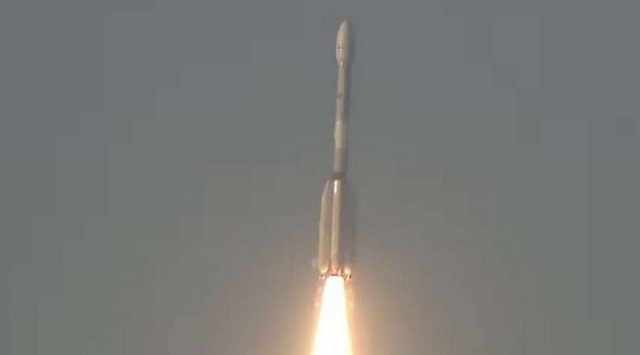New-Delhi: Indian Space Research Organisation (ISRO) successfully launched the INSAT-3DS satellite on GSLV-F14 from Satish Dhawan Space Centre in Sriharikota at 5:35 pm today.
The objective of this mission is to help India improve its ability to enhance the weather forecasting system, observe the ocean and warn people about disasters.
The three-staged GSLV rocket standing 51.7 metre tall and weighing 420 tonne rose up into the skies at 5.35 p.m. breaking free from the Earth’s gravitational pull.
The rocket carried India’s latest meteorological/weather satellite, INSAT-3DS weighing 2,274 kg, which would augment the Meteorological services with the presently operational INSAT-3D and INSAT-3DR in-orbit satellites, said the Indian Space Research Organisation (ISRO).
About 19 minutes into the flight, the GSLV rocket will deliver the satellite into a Geosynchronous Transfer Orbit (GTO) from where it will be further taken up by firing the onboard motors.
Subsequent orbit-raising manoeuvres will ensure that the satellite is positioned in a Geo-Stationary Orbit.
As the GSLV rocket ascended towards the skies, its engine roar reverberated over the rocket port like a rolling thunder much to the thrill of the people there.
The INSAT-3DS is India’s third generation meteorological satellite and is fully funded by the Ministry of Earth Sciences.
It is designed for enhanced meteorological observations and monitoring of land and ocean surfaces for weather forecasting and disaster warning, ISRO said.
Various departments under the Ministry of Earth Sciences, such as the India Meteorological Department (IMD), National Centre for Medium-Range Weather Forecasting (NCMRWF), the Indian Institute of Tropical Meteorology (IITM), National Institute of Ocean Technology (NIOT), Indian National Centre for Ocean Information Services (INCOIS) and various other agencies and institutes will use the INSAT-3DS satellite data to provide improved weather forecasts and Meteorological services.
ISRO said the primary objectives of the mission are to monitor the Earth’s surface, carry out oceanic observations and its environment in various spectral channels of meteorological importance; to provide the vertical profile of various meteorological parameters of the atmosphere; to provide data collection and data dissemination capabilities from the data collection platforms (DCPs); and to provide satellite-aided search and rescue services.
According to ISRO, Indian industries have significantly contributed to the making of the INSAT-3DS.
The satellite carries six Channel Imager, 19 Channel Sounder payload, Data Relay Transponder (DRT) and Satellite aided Search and Rescue (SA&SR) transponders.
The GSLV-F14 rocket is a three-staged vehicle. The first stage (GS1) is powered by a solid propellant motor having 139-tonne propellant and four Earth-storable propellant stages strap-on motors with 40 tonnes of liquid propellant in each.
The second stage is also an Earth-storable propellant stage loaded with 40-tonne propellant.
The third stage is a cryogenic stage with a 15-tonne propellant loading of liquid oxygen (LOX) and liquid hydrogen (LH2).
During the atmospheric regime, the satellite is protected by Ogive payload fairing or the heat shield.
GSLV can be used to launch a variety of spacecraft capable of performing communications, navigation, Earth resource surveys, and any other proprietary mission.
#WATCH | Andhra Pradesh: ISRO launched INSAT-3DS meteorological satellite onboard a Geosynchronous Launch Vehicle F14 (GSLV-F14), from Satish Dhawan Space Centre in Sriharikota.
(Source: ISRO) pic.twitter.com/abjPVJWkxh
— ANI (@ANI) February 17, 2024




 Ms Kalinga
Ms Kalinga